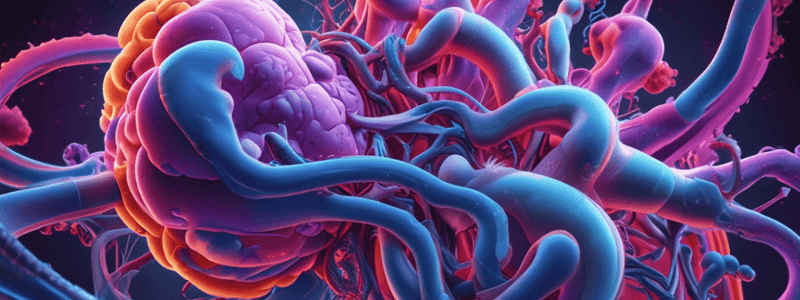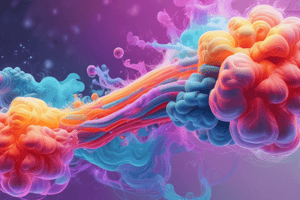Podcast
Questions and Answers
What is the total amount of carbon dioxide transported in 100 ml of arterial blood under normal resting conditions?
What is the total amount of carbon dioxide transported in 100 ml of arterial blood under normal resting conditions?
- 42 ml
- 48 ml (correct)
- 45 ml
- 3 ml
What is the main mechanism by which carbon dioxide is transported in the blood?
What is the main mechanism by which carbon dioxide is transported in the blood?
- Bicarbonate (correct)
- Carbamino compound
- Physical solution
- Carbonic anhydrase
What is the Cl- shift phenomenon?
What is the Cl- shift phenomenon?
- The transport of CO2 as carbamino compounds
- The exchange of Cl- and HCO3- ions between the red blood cells and plasma (correct)
- The dissociation of CO2 from hemoglobin
- The buffering of CO2 by hemoglobin
How does the Bohr effect differ from the Haldane effect?
How does the Bohr effect differ from the Haldane effect?
What is the main function of carbonic anhydrase in the transport of CO2?
What is the main function of carbonic anhydrase in the transport of CO2?
What percentage of the tidal CO2 is transported as carbamino compounds?
What percentage of the tidal CO2 is transported as carbamino compounds?
What is the purpose of the Haldane effect in the transport of CO2?
What is the purpose of the Haldane effect in the transport of CO2?
What is the main reason for the decrease in pH from 7.4 to 7.34 due to the transport of tidal CO2?
What is the main reason for the decrease in pH from 7.4 to 7.34 due to the transport of tidal CO2?
What happens to HCO3- as CO2 enters a red blood cell?
What happens to HCO3- as CO2 enters a red blood cell?
What is the main reason for the significant difference in chloride content between venous and arterial blood in red cells?
What is the main reason for the significant difference in chloride content between venous and arterial blood in red cells?
What is the relationship between CO2 tension (PCO2) and the total CO2 content of blood according to the CO2 dissociation curve?
What is the relationship between CO2 tension (PCO2) and the total CO2 content of blood according to the CO2 dissociation curve?
What is the effect of the HalDane effect at the lung with respect to CO2 content?
What is the effect of the HalDane effect at the lung with respect to CO2 content?
At the tissues, what happens to CO2 content when PO2 is 40mmHg and PCO2 is 46mmHg?
At the tissues, what happens to CO2 content when PO2 is 40mmHg and PCO2 is 46mmHg?
What happens to Cl- as CO2 moves from RBCs into the plasma at the lung?
What happens to Cl- as CO2 moves from RBCs into the plasma at the lung?
What is the effect on CO2 content in the absence of PO2 change according to the text?
What is the effect on CO2 content in the absence of PO2 change according to the text?
How does carbonic acid dissociate at the lungs?
How does carbonic acid dissociate at the lungs?
What happens to the PO2 upon entering the lungs?
What happens to the PO2 upon entering the lungs?
What is the consequence of the shift of the CO2 dissociation curve down?
What is the consequence of the shift of the CO2 dissociation curve down?
Which type of hypoxia is due to decreased oxygen in the inspired air?
Which type of hypoxia is due to decreased oxygen in the inspired air?
What does the Bohr effect involve?
What does the Bohr effect involve?
What is cyanosis?
What is cyanosis?
Which condition is characterized by tissues being unable to use oxygen?
Which condition is characterized by tissues being unable to use oxygen?
Where does cyanosis typically manifest in the body?
Where does cyanosis typically manifest in the body?




